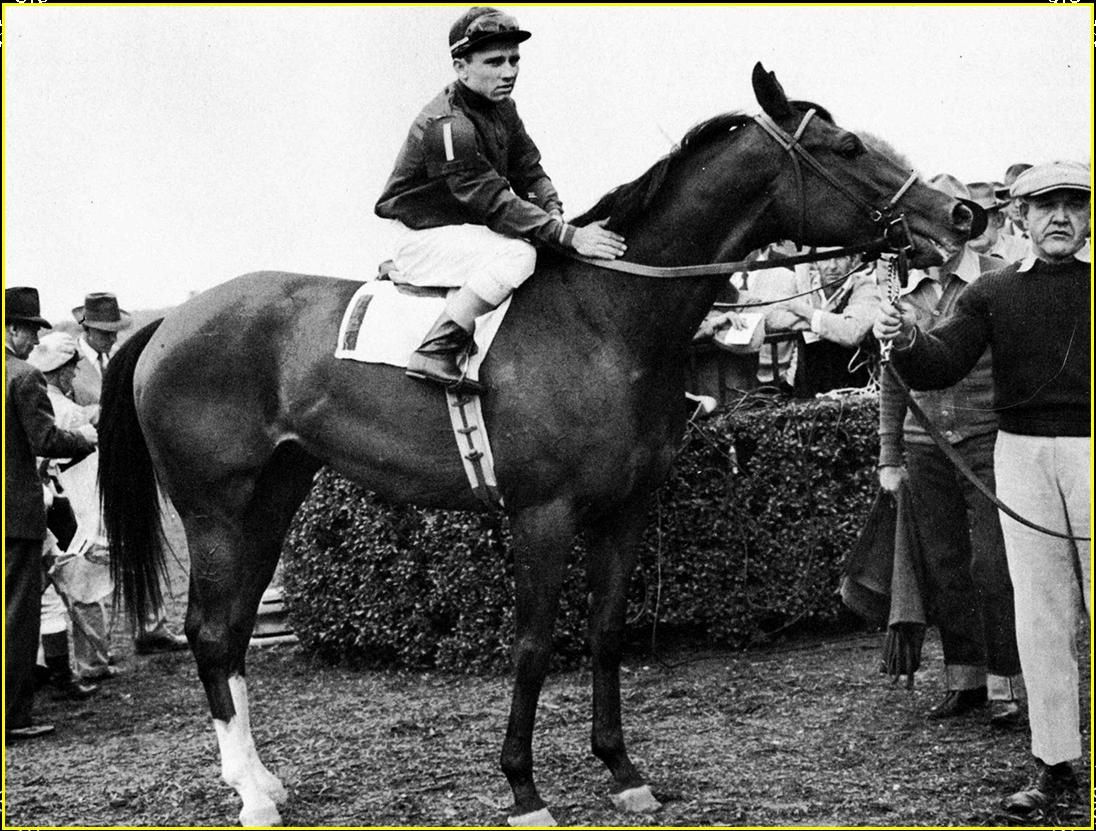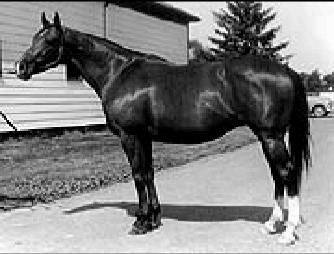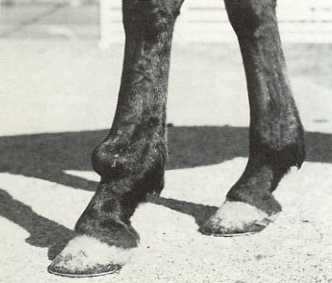Two Lea raced for the legendary Calumet Farms at a time when her stablemates included Citation, Coaltown, Bewitch, Armed, and Hill Gail. A daughter of Calumet's leading sire Bull Lea, Two Lea was out of Two Bob, the 1936 Kentucky Oaks winner and a daughter of The Porter. Two Bob had already produced the stakes winning filly Twosy, and later produced Miz Clementine, whose sixteen wins included the Hollywood Oaks, the California Oaks, the California Derby, the Vagrancy Handicap, and the Cinema Handicap. As a yearling, Two Lea developed ringbone and this lameness kept her away from the races for most of her juvenile season. It wasn't until late August that she made her first start, running third in a five and a half furlong maiden special weight at Washington Park. She was third again three weeks later at Belmont Park. Four days later, she finally showed her true talent, easily coasting home four lengths in front, in a six furlong maiden special weight over the Course. This was her last start of the season. Two Lea came back as a three-year-old with a impressive allowance victory at Havre de Grace. She came from well back to claim first money in a hard stretch drive, beating a filly by a nose. She won another allowance race by three-quarters of a length, a month later at Belmont Park. Two Lea's first stakes race came three weeks later at Arlington when she went to the gate for the Princess Doreen Stakes. Second at the top of the stretch, Two Lea came driving home to beat No Strings by a length and a quarter. Next time out, Two Lea met older fillies and mares in the Modesty Stakes, but it was another three-year-old, No Strings, that beat her to the wire. Two Lea was a half length behind in second. It was her only loss of the season, and she had conceded ten pounds to the winner. In the one mile Cleopatra Stakes, Two Lea met Wistful, the leading filly on the east coast and a fellow Calumet homebred. Two Lea proved the better filly that day, galloping off to a five length lead before being eased and finally winning by two lengths while her illustrious stablemate was beaten a neck for second money. Next came an impressive victory in the seven furlong Artful Stakes at Washington Park. Trailing the field in the early going, Two Lea closed strongly to win by a length and a half in a new track record time of 1:21 4/5 (two-fifths shy of the world record). The filly was then given the next four months off. Two Lea's final race of 1949 was an allowance race at Santa Anita on December 29. She won beating the top mare, But Why Not, who had earned divisional honors as a three-year-old in 1947. Two Lea shared the title of Champion Three-Year-Old Filly with her stablemate, Wistful. A week after this Santa Anita allowance victory, Two Lea officially raced as a four-year-old, winning an overnight handicap by a neck while giving six pounds to runner up, Gaffery.
Next she carried the high weight of 126 pounds in the mile and an eighth, Santa Margarita Handicap. Running on a muddy track, Two Lea came home the two length winner over Gaffery and But Why Not. Two Lea met the colts for the first time in the Santa Anita Maturity at a mile and a quarter. She had Eddie Arcaro on top for the first and only time in her career. The filly held the lead to the head of the stretch, however when stablemate Ponder (1948 Ky derby winner) moved up to challenge, she gave way. Ponder came home the winner with Two Lea a second. Two Lea met Ponder again in the Santa Anita Handicap. She also faced the great Citation in the race and all three of Calumet's stars were asked to give weight to Noor. Noor, son of Nasrullah was to be the handicap champion of 1950, and his record breaking duels with Citation that season are now legendary. His deeds would help inspire the importation of his sire, Nasrullah, who would lead the American sire's list five times. Even the mighty Citation couldn't catch the lightly weighted (110 lbs) Noor, put all three Calumet entries gave it a game try. Citation, carrying 132 pounds, was second. Two Lea was a length back, gamely fighting off Ponder to finish third by a neck. Two Lea got another four months off after this effort. She returned to the races at Arlington in July. She ran just once in an overnight handicap. She was forced wide and ended up second while conceding seven pounds to the winner, Porter's Broom. Two Lea then got another long layoff while she recovered from having her ringbone pinfired. Her performances that winter were enough to merit the title of Champion Handicap Mare of 1950.
Due to this ankle problem, Two Lea set out all of 1951. At the age of six in 1952, Two Lea attempted a comeback, running out of the money at Golden Gate and then winning an allowance event at Hollywood Park. After running second by a neck to stablemate Jennie Lee in another allowance race, Two Lea returned to stakes company. She was second to another stablemate, Twilight Tear's daughter, A Gleam, in the Milady Handicap. Then she won the Vanity Handicap from her old rival, Wistful, despite giving ten pounds. After a fourth place effort in the Inglewood Handicap, Two Lea won the Ramona Handicap by a length while Princess Lygia dead heated with Ruth Lily for second money. Next came the finest race of her career. Two Lea gave thirteen pounds to runner up Cyclotron in winning the Hollywood Gold Cup by a half length. Her time for the mile and a quarter was a impressive 2:00 1/5. That fall, Two Lea raced at Bay Meadows, winning both the San Mateo Handicap and the Children's Hospital Handicap while carrying top weight. She was second in her final race, the Bay Meadows Handicap while giving away eleven pounds to the winner, Moonrush. This was her last race, capping her life time earnings of $309,550. Two Lea was retired to Calumet Farm Stud and booked to Count Fleet the following spring. . As a broodmare, Two Lea produced dual classic winner Tim Tam, Champion Three Year Old Colt in 1958 and was elected into the Hall of Fame in 1985. Her son On-and-On won the Brooklyn Handicap, the Ohio Derby, the Tropical Park Handicap, and a number of other stakes. His full brother Pied D'Or was also a stakes winner, scoring in the Camden, Paumonok, and Princeton Handicaps.
Two Lea passed died in 1973 and was buried at Calumet Farm. She was inducted into racing's Hall of Fame in 1982.
It may be seen from the above tables that the Jones' scheduled 23% of her races, 7 days or less between starts. It is curious that her lifetime soreness did not seem to affect her racing schedule to a large extent as dictated by this type of close racing. As stated above, ringbone problems plagued her during her two year old campaign and this can be seen in her limited starts of 1948. Nevertheless, her closest race scheduled was during this very two year form, 4 days. The September 17th, 1948 race in which she broke her maiden was a Maiden Special Weight for fillies' race in which she won in 1:10.2 on a fast track. This win was 4 days after another Maiden Special Weight race of Sept 13th in which she had finished 3rd, bearing out. Chances are her ringbone was on her left front leg which caused this bearing out. Her ringbone problems again flared up in 1950 resulting in her being pin-fired after the July 15th race. All of 1951 was given to her for healing. 1952 was her last year in which she appeared to have overcome much of her ringbone soreness, though she was given a long 106 day break towards the end which suggests of further unsoundness.
I consider it very interesting that even though this mare was sore much of her career, that she was not babied in the sense as today's modern trainers would have handled such a mare. Note that of the uninterrupted 8-race session, she experienced in 1952, she had 3 races scheduled within 7 days of each other. That would be approximately 42% of her races being raced 7 days apart. Modern trainers would scoff at such a schedule, saying such training tactics would surely ruin any race mare. Perhaps, they are right, considering the modern habit of giving horses very little bottom or foundation in training preps. One has to admit that soreness prone mares are very hard to train and, surely, if Two Lea was abused, she would never have shown such nice races, so close apart for the Jones to the very end. I consider the Jones to be wizards in knowing how to prepare a horse to withstand the rigors of racing stress. Prepare a horse properly and that horse will be able to race often and thrive, even in the imperfect world of lameness and other common racehorse afflictions. Much can be learned in the study of Two Lea's racing regime

















